
20 Aug Intro to Macronutrients: Proteins – By John Murphy MSc, PhD researcher
By John Murphy (MSc, PhD researcher)
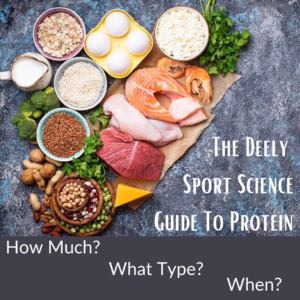
Protein, and the various amino acids that make up protein, are the main building blocks that create and resynthesise muscle mass. While most people focus on protein consumption directly after exercise, particularly a gym session, the total amount of protein that is consumed in a day/week will have a far greater impact on recovery and muscle building. In this article, we will take a look at:
- How to set and reach total protein targets
- What types of protein are best and why
- How best to time protein servings
- Amounts of protein in common foods
- Practical tips to implement all of the above
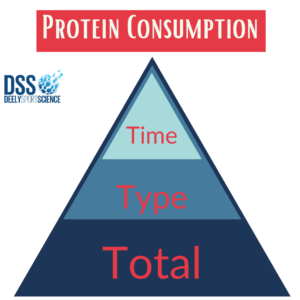
We’ve structured the article in terms of the overall amount of protein required and why (Total), followed by the various sources of protein we can consume (Type) and finally when is best to consume a serving, or servings of protein (Time).
Total
General health guidelines for overall protein intake come in around 0.8g/kg of total bodyweight. While this is often considered too low for even the general population to “perform” optimally, it is certainly too low for those who wish to perform at even a moderate level of sport. The majority of sports nutritionists will recommend 1.6 to 2.2g/kg of bodyweight. Before you open the calculator on your phone to work out how much you need check out the guidelines we’ve provided on how much you should eat based on bodyweight and on specific goals which will help in narrowing these recommendations below.
Table 1 – Ranges Of Protein Intake By Bodyweight
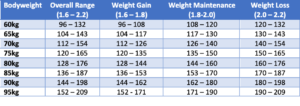
The range of protein recommendations is quite large. For example, an 80kg athlete could consume between 128 and 176 grams of protein a day and still be within the ideal range, although the difference could be up to two small chicken fillets. To refine the recommendations a little further we can align them to specific goals, whether they wish to increase (lean) weight, maintain current weight or lose weight. The lower end of recommendations will suit those wishing to gain weight as the main priorities are excess calories (generally 300-500 per day) and a stimulus (weight training). The extra calories (from either carbohydrate or fat) will provide more than enough fuel for recovery and growth. As protein is quite satiating (leaves you feeling fuller) it is advisable to aim for the lower end as you won’t feel as full and so find it easier to consume extra calories through carbohydrate and fat. The extra carbs will also help in fuelling the gym sessions required to increase muscle mass. Those who wish to maintain weight will need to remain in calorie balance (see previous article) and consuming 1.8 to 2g/kg will provide enough protein to ensure muscle mass is both maintained and in a position to recover from the normal demands placed upon them through general training. For those who wish to lose weight, protein recommendations are a little higher. It’s generally accepted that higher protein consumption will lead to greater muscle preservation (and so increased fat loss) although previous work by Eric Helms suggests that resistance training is the key determinant in maintaining muscle mass when losing weight. The key benefit to a higher protein intake when dieting is the aforementioned higher levels of satiety. Higher protein foods lead to a greater feeling of fullness and take longer to digest, which tends to leave us feeling fuller for longer. While it is possible to eat higher levels of protein than 2.2g/kg (as a number of studies by Jose Antonio showed no adverse effects) it often leads to a more expensive diet as foods higher in protein tend to cost more. Below are two lists of common foods. Table 2 is of foods that are quite high in protein and how many grams contained in a common portion. Table 3 is of some other foods which contain moderate amounts of protein and the calorie content of each.
Table 2 – Grams Per Portion Of “High Protein” Foods

*Portion sizes will vary based on individual suppliers and appetites
Table 3 – Grams & Calories Per Portion Of “Other” Foods

*Portion sizes will vary based on individual suppliers and appetites
It’s worth noting that many foods that are not traditionally known for their protein content are relatively high although the extra carbohydrate and/or fat will lead to increased calories. This can be beneficial to those who are looking to increase weight but caution should be exercised for those adhering to relatively strict calorie limits.
Type
The type of carbohydrate we eat gets a lot of attention (and will be explored in the next article of this series) but we rarely think about the type of protein we eat. The amino acids that make up protein vary across different food types. Recent research has found that of those amino acids, leucine contributes to muscle protein synthesis more so than any other. It’s certainly not necessary to spend ages reading the labels of our foods to examine their amino acid profile as foods derived from animal sources have the highest levels of leucine. Red and white meats such as beef, pork, ham, chicken and turkey along with various types of fish will provide enough leucine once we’re eating within the protein recommendations outlined above. Eggs and dairy products (such as milk and yoghurt) are also high in leucine as they are derived from animals. While it is possible to consume enough protein when eating an animal-free diet (such as vegan or vegetarian) it is more difficult and will be addressed in a separate article along with a number of other key points that should be taken into account when considering any form of specific diet.
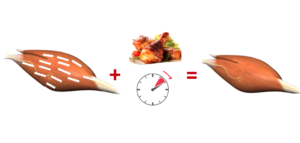
Time
Most food timing considerations are applied to protein ingestion directly after exercise. I’ve often seen players rush to gulp down their protein milk on the side line before they’ve even begun the cool-down or gym-goers rattle their shaker while still on the last exercise for fear of limiting gains. While it certainly is important to consume a meal after training to aid recovery, the immediate rush for protein is most likely not required and it’s also likely that carbohydrate is even more important. Protein is digested quite slowly by the body, particularly when compared to carbohydrate. As we’d ideally have our pre-game meal 2-3 hours before the game starts, and this should include even a modest serving of protein, the amino acids from this meal would still be circulating in our bloodstream as the game or session ends. As figure 3 illustrates, we break down muscles when playing sport or in the gym via a number of micro tears. These tears can take up to 48 hours to heal. As it takes so long to heal, we require some level of protein to be in our system the majority of the time. Regularly eating 20-40g portions of protein will ensure we have access to the various amino acids that support recovery and muscle turnover. See figures 4A and 4B for two example days of eating. Both have the same overall protein content but example 2 spreads the portions out far more evenly across the day.
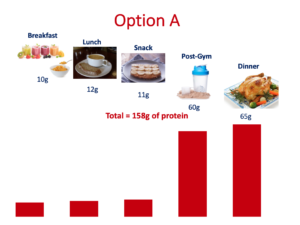
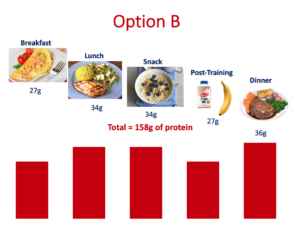
If we were to prioritise one particular meal that should include a decent serving of protein (although ideally they all would) then breakfast would be the most important as we’ve gone so long without any (because we’re hopefully asleep for 7-9 hours). See figure 5 for examples of protein based breakfasts.
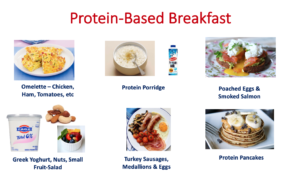
Practical Tips
- The majority of this article spoke about grams of protein. While it is worth tracking what you eat for a week to ten days as an educational experience, it’s certainly not necessary all of the time. A simple way of measuring portions of protein is to aim for a palm-sized piece at each meal.
- As it can be harder to pick up decent portions of protein on the go, it’s worth batch cooking some options in advance such as:
- 4-6 chicken fillets at a time in the oven.
- Egg and ham muffins.
- Homemade beef or turkey burgers.
- Overnight oats with protein milk or whey protein.
- Try not to count protein bars towards your daily intake of protein. The content is generally quite poor and not easily digested by the body.
- Double cook your protein source at dinner time so you have an extra portion for tomorrow’s lunch.
- Whey and casein protein powders count as animal sources as they originally come from milk. They are also high quality protein in terms of how easily they can be absorbed by the body. They are not particularly satiating and often have minimal impact on hunger levels.
TL;DR
Eat 4-5 palm-sized portions of protein that mainly come from animal sources which are evenly spaced throughout the day.
The next instalment will look at carbohydrates and how they fuel the body.
If you want further information on anything said here then feel free to contact me (John) at [email protected].
You can find my profile on The Twitter Machine or The Gram for more recipes and nutrition info.

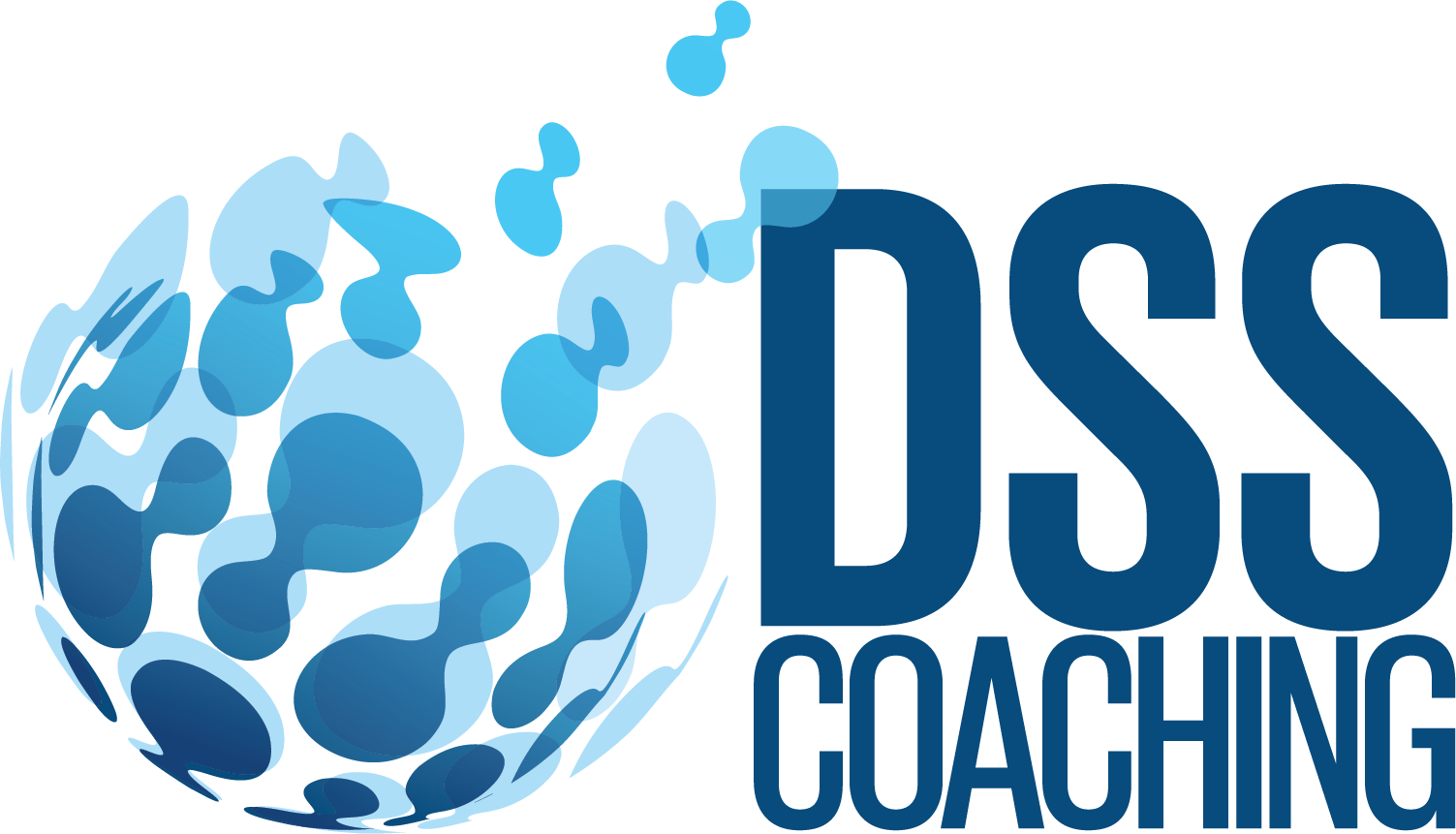

No Comments